Related Research Articles

Father Damien or Saint Damien of Molokai, SS.CC. or Saint Damien De Veuster, born Jozef De Veuster, was a Roman Catholic priest from Belgium and member of the Congregation of the Sacred Hearts of Jesus and Mary, a missionary religious institute. He was recognized for his ministry, which he led from 1873 until his death in 1889, in the Kingdom of Hawaiʻi for people with leprosy, who lived in government-mandated medical quarantine in a settlement on the Kalaupapa Peninsula of Molokaʻi.
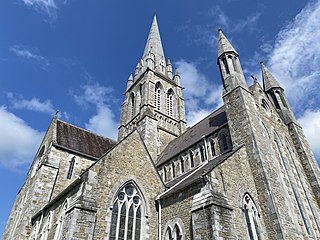
Killarney is a town in County Kerry, southwestern Ireland. The town is on the northeastern shore of Lough Leane, part of Killarney National Park, and is home to St Mary's Cathedral, Ross Castle, Muckross House and Abbey, the Lakes of Killarney, MacGillycuddy's Reeks, Purple Mountain, Mangerton Mountain, Paps Mountain, the Gap of Dunloe and Torc Waterfall. Its natural heritage, history and location on the Ring of Kerry make Killarney a popular tourist destination.
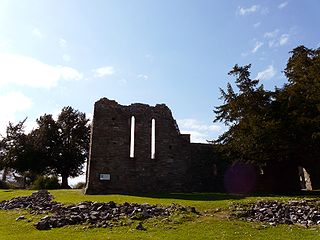
Innisfallen or Inishfallen is an island in Lough Leane; one of the three Lakes of Killarney in County Kerry, Ireland.

Saint Ciarán of Clonmacnoise, supposedly born Ciarán mac an tSaeir, was one of the Twelve Apostles of Ireland and the first abbot of Clonmacnoise. He is sometimes called Ciarán the Younger to distinguish him from the 5th-century Saint Ciarán the Elder who was bishop of Osraige. His name produced many variant spellings, including Ceran, Kieran, Queran and Queranus.
The School of Mayo was an early Catholic monastery in Mayo, Ireland, founded by Saint Colmán of Lindisfarne, c.668. It became famous for sanctity and learning, but suffered from raids of natives and foreigners, especially during the 14th century.

Kalaupapa National Historical Park is a United States National Historical Park located in Kalaupapa, Hawaiʻi, on the island of Molokaʻi. Coterminous with the boundaries of Kalawao County and primarily on Kalaupapa peninsula, it was established by Congress in 1980 to expand upon the earlier National Historic Landmark site of the Kalaupapa Leper Settlement. It is administered by the National Park Service. Its goal is to preserve the cultural and physical settings of the two leper colonies on the island of Molokaʻi, which operated from 1866 to 1969 and had a total of 8500 residents over the decades.

Finnian of Clonard – also Finian, Fionán or Fionnán in Irish; or Finianus and Finanus in its Latinised form (470–549) – was one of the early Irish monastic saints, who founded Clonard Abbey in modern-day County Meath. The Twelve Apostles of Ireland studied under him. Finnian of Clonard is considered one of the fathers of Irish monasticism.
Finan may refer to:
Finan Came or Finian Abbot of Kinnity, an early Irish saint. Finan of Lindisfarne, second Bishop of Lindisfarne from 651 until 661. Finian Lobhar an early Irish saint credited with founding a church and monastery at Innisfallen in Killarney.

Virgil, also spelled Vergil, Vergilius, Virgilius, Feirgil or Fearghal, was an Irish churchman and early astronomer. He left Ireland around 745, intending to visit the Holy Land; but, like many of his countrymen, he settled in Francia. Vergilius served as abbot of Aghaboe, bishop of Ossory and later bishop of Salzburg. He was called "the Apostle of Carinthia" and "the geometer".

Kinnitty is a village in County Offaly, Ireland. It is located 13 km east of Birr on the R440 and R421 regional roads.
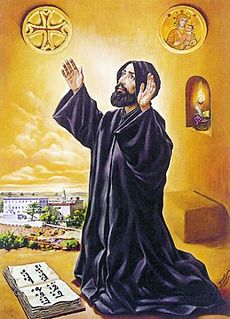
Nimatullah Kassab O.L.M., also known as "Al-Hardini" in reference to his birth village, was a Lebanese monk, priest and scholar of the Maronite Church. He has been declared a saint by the Catholic Church.

Saint Winwaloe was the founder and first abbot of Landévennec Abbey, also known as the Monastery of Winwaloe. It was just south of Brest in Brittany, now part of France.
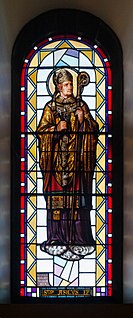
Saint Assicus(Asicus, Assic) was the first bishop of Elphin, Ireland, and venerated as the patron saint of that place. He was also an artisan metalworker.
Columba of Terryglass (Colum) was the son of Ninnidh, a descendant of Crinthainn, King of Leinster. Columba was a disciple of St. Finnian of Clonard. He was one of the Twelve Apostles of Ireland.
Saint Fintán, or Munnu is one of the saints of Ireland and Britain who served in Ireland and Scotland being the founder and abbot of the abbey at Teach-Mhunn - The House of Saint Munn - where his bed may be visited is a pilgrimage site; today Taghmon is in the County Wexford, in the province of Leinster Ireland. In Scotland, he is venerated as the patron saint of Clan Campbell.
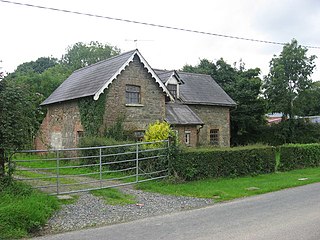
Drumcar is a village and a historical parish, in the barony of Ardee, County Louth, Leinster, northeastern Ireland.

December 11 - Eastern Orthodox liturgical calendar - December 13

Finan Cam, Abbot of Kinnity was an early Irish saint associated with County Kerry, Ireland, who lived in the 6th century AD, and possibly the 7th century. To distinguish him from other saints of the same name the appellation of Cam or "crooked" has been given to him, either because he was stooped or because he had a squint. His feast day is 7 April.

St. Finian's Bay is an exposed bay on the Atlantic coast of County Kerry, Ireland.

The River Laune Crozier is a late 11th century Insular crozier, now at the Archaeology branch of the National Museum of Ireland. The object would have been comissioned as a staff of office for a senior clergyman, most likely a bishop. It consists of a wooden core decorated with fitted bronze and sliver metal plates. Although the metalwork is somewhat corroded in parts, it is fully intact and considered one of the finest surviving Irish examples, alongside those found at Clonmacnoise and Lismore.
References
- 1 2 "St. Finian Lobhar", Catholic Online, retrieved 2021-07-06
- ↑ Healy 1890, pp. 439–440.
- 1 2 Alban, Butler (1821). The lives of the fathers, martyrs, and other principal saints. London: John Murphy. p. 165.
- ↑ Bunson, Matthew, Margaret, and Stephen (2003). Our Sunday Visitor's: Encyclopedia of Saints (Revised). Huntington, Indiana: Our Sunday Visitor. p. 324. ISBN 1-931709-75-0.
- ↑ "St. Finian Lobhar - Saints & Angels - Catholic Online". www.catholic.org. Retrieved 2015-12-22.